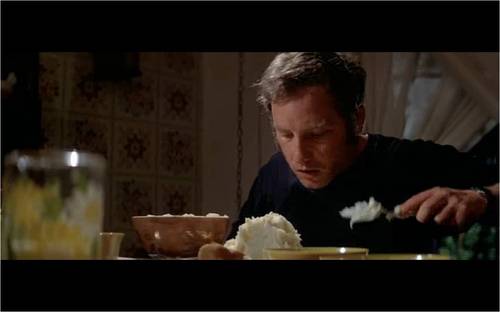About an hour’s drive northeast of Salt Lake, high in the mountains above Ogden City, you’ll find a sleepy little burg called Huntsville, Utah. The surrounding hillsides are dotted with summer homes and vacation cabins, and signs near Pineview Reservoir — the pocket-sized lake that defines the town’s western edge — excitedly proclaim the coming of beachfront condos, leaving little doubt that this bucolic hamlet is going to end up as just another anonymous bedroom community before too many more years pass. But for now, at least, cows still graze contentedly at the roadside, and traffic along the main drag through town frequently bogs down behind slow-moving tractors and combines. It’s a great place to escape to for an afternoon; The Girlfriend and I have been going up there at least once a summer for over a decade now.
We drive the old two-lane highways, enjoying fresh mountain air with the top down, and once we get there, we always enjoy lunch at a quirky little bar called the Shooting Star Saloon, which claims to be the oldest continuously operating tavern in the state. (I’ll write more about that place some other time.) But before we go for Star Burgers and beer, we like to stop into the monastery nestled against the mountains on the other side of town.
Yes, believe it or not, there is a Catholic monastery in Mormon-dominated Utah. The Abbey of Our Lady of the Holy Trinity was founded in 1947 by Trappist monks, who set up housekeeping in several World War II-surplus Quonset huts with plans to build more permanent structures sometime in the future. It never happened. The whitewashed humps of the Quonsets are still there, shaded by trees that have grown tall and grand in the last 65 years. But the monks have made do, as their kind does, and their abbey, surrounded by a buffering ring of farmland, is a lovely green respite from the outside world.
I don’t recall how or when I first heard about the abbey. It may have been back in college, when stories went around of a place where young men could go for a few days when they needed to clear their heads. Many a time, I considered taking one of those retreats myself, when the weight of everything I was going through with classes and girls and growing up got to be too much. But I always chickened out. Not being religious, let alone Catholic, it didn’t seem like the best fit, no matter how alluring the idea of unplugging from the world and spending some time just thinking may have been. It felt like I would’ve been taking unfair advantage of someone’s hospitality. At some point, though, I learned about the honey, produced by the monks themselves from hives they kept on the grounds and sold through a tiny gift shop they maintained near their chapel. And that was what finally convinced me to go for a visit.
It turned out you could buy a lot of goods made by the monks in that shop — honey in various flavors and consistencies, bread, oatmeal — as well as St. Christopher medals and holy water that would be blessed for you on the spot, and books and rosaries and candles and other goods of interest to Catholics. I never purchased any of those items, naturally, but I brought home lots of honey over the years, and I sampled the oatmeal, too — simple, coarse stuff, very unlike machine-made Quaker Oats. Often times, I bought more than I needed, so much that it would take me a couple years to get through it all, but I liked the idea that I was supporting a unique local industry. And it really was good honey, which helped.
Anne and I somehow missed going to Huntsville last year. Not sure why; just busy I guess. A few weeks ago, we decided on the spur of the moment that we were long overdue and it was time to re-affirm our tradition. It was my birthday, as it happens, and it was a glorious day, the kind I love, when the sky is like a hard crystal dome arching impossibly high above you and the air is so clear it seems to sparkle a little. For the first time in several years, I was not crashingly depressed by the thought of making another orbit around the sun. I wasn’t thinking much about the passage of time at all, in fact… until we stepped into the little gift shop by the chapel at the Abbey of Our Lady of the Holy Trinity and saw that there was no honey on display. No oatmeal or bread, either. In fact, the only food for sale was some caramels, made by nuns in a convent in another state. Puzzled, I turned to the monk sitting near the cash register and politely waited for him to set aside his reading.
“Do you not carry the honey anymore?” I asked.
The father looked at me through pale, watery eyes, and smiled ruefully. “No,” he said, “I’m afraid we sold the last of it sometime last year. Brother So-and-So has gotten too old to care for the hives, you see, and he has no one to help.”
“That’s a shame,” I said. It suddenly occurred to me that this man — whom I’m certain I’ve encountered before on my annual visits, many times — suddenly appeared to be much smaller and more frail than I remembered.
“Our average age now is 82,” the monk continued. “There are only 18 of us left, and two of us are in a nursing home. So you understand we’ve had to make some changes.”
I found myself apologizing to the monk, although I don’t know what for. Skipping the prior year’s visitation, perhaps, and feeling like I’d come too late. Or perhaps I felt sympathy for the man’s advancing age and obvious physical deterioration. Maybe I was thinking of the articles I’ve read about the Catholic Church’s inability to attract young men to the clergy anymore, signifying the decline of this gentle man’s whole way of life. Maybe I was just sorry to realize that this unique gem of my home state probably doesn’t have much longer before it gets subdivided, too. I bought a candle and some caramels for Anne, to soothe my own feelings as much as the monk’s, and then we drove to the Shooting Star, where I drank a couple glasses of Coors Light and pondered the unfair cruelty of a world where men can work hard at building something for six and a half decades, only to find at the end of their lives that no one is interested in continuing their legacies after they’ve gone. That all their efforts ultimately amounted to nothing. I’m sure the monks wouldn’t see their lives as exercises in futility; I’m not sure I could see my own in any other way, were I in their shoes.
For the record, I still have one cup of “Trappist Honey” left in my kitchen pantry. Brandy flavored. It’s pretty old, but I don’t think honey goes bad, does it? I intend to try it before too much longer, and to use it up if it hasn’t gone rancid. And once it’s gone, I’ll clean out the cup — or at least the lid — and carefully store it in the Bennion Archives. Another souvenir of another thing that once mattered to me, and is — or at least soon will be — no more…




